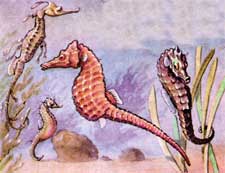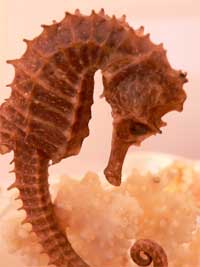|

Easy to see through: The seahorse is a true fish, with a dorsal fin located on the lower
body and pectoral fins located on the head near their gills. Mostly
transparent, these often don't show in pictures and even with live
animals most people do not see them at first.

 Horse Doctor: Seahorse populations have been endangered in recent years by overfishing.
The seahorse is used in traditional Chinese herbology, and as many
as 20 million seahorses may be caught each year and sold for this
purpose. Horse Doctor: Seahorse populations have been endangered in recent years by overfishing.
The seahorse is used in traditional Chinese herbology, and as many
as 20 million seahorses may be caught each year and sold for this
purpose.
First Cousins: Though close relatives of seahorses, sea dragons have bigger bodies
and leaf-like appendages which enable them to hide among floating
seaweed or kelp beds. Sea dragons feed on larval fishes and amphipods,
such as small shrimp-like crustaceans called mysids ("sea lice"),
sucking up their prey with their small mouths. Many of these amphipods
feed on red algae that thrives in the shade of the kelp forests
where the sea dragons live.
 Let Freedom Reign: While many aquarium hobbyists keep seahorses as pets, seahorses
collected from the wild do not tend to fare well in a home aquarium.
They will only feed on live foods such as brine shrimp and are prone
to stress in an aquarium, which lowers their immune systems and
exposes them to diseases. In recent years, however, captive breeding
of seahorses has become increasingly widespread. These seahorses
tend to do much better in captivity. They are less likely to carry
diseases, they will accept frozen foods such as mysid shrimp, and
they aren't exposed to the shock and stress of being taken out of
the wild and placed in a small aquarium. Captive-bred seahorses
are more expensive, but are a better investment as they are much
hardier and don't take a toll on wild populations. Seahorses can
be kept in an aquarium with other seahorses, pipefish, and other
non-aggressive, slow moving fish. Seahorses are slow feeders, and
in an aquarium with fast, aggressive feeders, the seahorses will
be edged out during feeding. For this reason, there are a limited
number of tankmates that can be kept successfully with seahorses. Let Freedom Reign: While many aquarium hobbyists keep seahorses as pets, seahorses
collected from the wild do not tend to fare well in a home aquarium.
They will only feed on live foods such as brine shrimp and are prone
to stress in an aquarium, which lowers their immune systems and
exposes them to diseases. In recent years, however, captive breeding
of seahorses has become increasingly widespread. These seahorses
tend to do much better in captivity. They are less likely to carry
diseases, they will accept frozen foods such as mysid shrimp, and
they aren't exposed to the shock and stress of being taken out of
the wild and placed in a small aquarium. Captive-bred seahorses
are more expensive, but are a better investment as they are much
hardier and don't take a toll on wild populations. Seahorses can
be kept in an aquarium with other seahorses, pipefish, and other
non-aggressive, slow moving fish. Seahorses are slow feeders, and
in an aquarium with fast, aggressive feeders, the seahorses will
be edged out during feeding. For this reason, there are a limited
number of tankmates that can be kept successfully with seahorses.

A Male Mommy: Seahorses reproduce in an unusual way: the male becomes pregnant.
The mating pair entwine their tails and the female aligns a long
tube called ovipositor with the male's pouch. The eggs move through
the tube into the male's pouch where he then fertilizes them. The
embryos will develop for between ten days and six weeks, depending
on species and water conditions. When the male gives birth he pumps
his tail until the baby seahorses emerge.
All text is available under the terms
of the GNU Free Documentation License
|